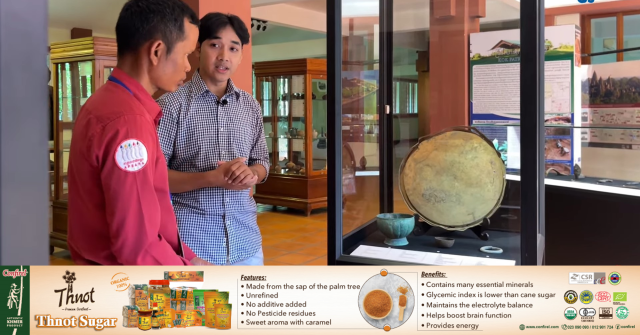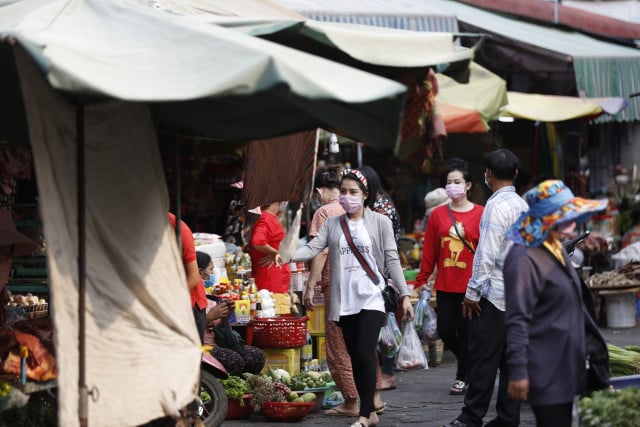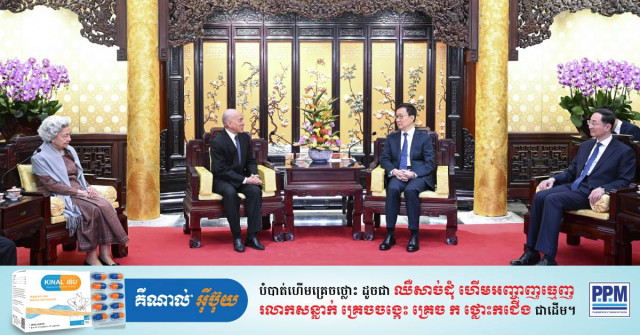Hidden Treasures of the West Mebon Temple Now on Display

- By Zul Rorvy
- December 10, 2023 7:10 PM
SIEM REAP - Small objects can offer insights into the lives of a people’s ancestors. During the restoration of the West Mebon temple in Siem Reap province, a number of artefacts were discovered and are now on display at the Preah Norodom Sihanouk-Angkor Museum in Siem Reap province.
Ranging from ceramics to iron and bronze objects, these artifacts have helped researchers learn about the daily tasks of people during the Angkorian empire, as Phouy Savoeut, acting director of the museum, explained during an interview.
_1702112413.png)
Zul Rorvy: Would you tell us about these objects found at the West Mebon temple?
Phouy Savoeut: These artefacts…date from the 11th century up to recent times. The oldest one is about 900 years old.
Our experts have found a variety of materials such as iron, bronze and ceramics. Inside a ceramic pot, we discovered a Buddha statue made of wax. Some other metal objects were tools that builders used to construct parts of the temples. This seems to be a chisel used to sculpt a bas-relief on the surface of the stones.
Some other metal objects were ornamental components used to give the temples their aesthetic looks. A circular metal tray, two metal bowls and a bracelet were also found there.
Unlike other temples, the West Mebon has provided us with a lot of archaeological evidence regarding construction tools. These were unearthed at the temple’s foundation level and entrances during its most important restoration phase.
A significant discovery made in 1931 by French architect and archeologist Henri Marchal consisted of a large, broken bronze statue of the reclining Vishnu at the West Mebon temple. The statue, of which only the upper body remains, is on display at the National Museum of Cambodia in Phnom Penh.
Regarding the Buddha sculpture made of wax that had been put in a ceramic pot, this could be a creation of a post-Angkorian period, this, because the cloth threads that we found inside the pot are still in relatively good condition. We think that it is linked to a local spiritual belief. [In some cultures, including that of Cambodia, cloth threads are thought to have the capacity of containing magic spells].
_1702112633.png)
Involving complex topography, the restoration of the West Mebon’s foundation was conducted between 2012 and 2018.
The temple is surrounded by a water reservoir called the West Baray, which measures 8-by-2 kilometres, and has a square pond inside it. Studies have shown that there used to be 12 entrances or towers leading to the inner area of the temple, that is, three entrances on each side.
Some other artefacts that we have found include roof tiles, wood supporting the columns, as well as potteries from outside the country. Since they are very deteriorated, we decided to keep them in storage.
Potteries were perhaps buried by the ancestors during religious activities. Regarding the making of the metal objects that we found, perhaps they ended up buried when accidentally dropped on the construction site or something similar.
_1702112700.png)
Zul Rorvy: So, when can the public see these objects?
Phouy Savoeut: The Preah Norodom Sihanouk-Angkor Museum is open from Tuesday to Sunday, 8:30 am to 4:30 pm. Our museum guides are trained in archeology and can help visitors tour, and this, free-of-charge in languages such as Khmer, English and Japanese.
About the West Mebon temple and its restoration
Evidence suggests that the temple was constructed around the 11th century during the reigns of King Suryavarman I and King Udayadityavarman II. The site is located about 13 kilometres, that is, a 20-minute drive or so, from downtown Siem Reap city.

Since the temple is in the middle of a water reservoir, rainfalls and droughts cause the water level to fluctuate, making the temple’s foundation very unstable as stones deteriorate quickly, which makes restoration highly difficult.
In the early 1900s, experts from the École française d'Extrême-Orient, or EFEO, went about restoring some parts of the temple.

Hang Peou, hydrologist and director general of the APSARA National Authority that manages the Angkor Archeological Park, said during an interview that the West Mebon played an important role for the Angkorian empire’s water management. It served as the control centre to calibrate the irrigation system, including the canals and reservoirs, for agricultural and religious purposes, he said.

Its restoration, which is now being done, takes tremendous time and efforts since the experts and workers working on the site as well as every component such as the equipment, machinery and even the replacement stones must be transported by boat across the baray. Strong winds and the water not-contained by the dike also impede the work. Restoration is being done while respecting the original materials and techniques.

The West Baray is a popular place among Cambodian visitors. People often have lunch at local food stalls set up along the reservoir. Local villagers also offer boat rides on the baray. There also are several smaller temples along the West Baray, most notably the Ak Yom temple where a pre-Angkorian inscription dating from 674 was found.
Originally written in Khmer, the story was translated by Ky Chamna for Cambodianess.
To watch the original interview in Khmer, click here.
Related stories and videos:
Exhibition of Artefacts from the West Mebon Temple in Siem Reap
Restoration Is Nearing Completion at the West Mebon Temple, so often Flooded
Restoring Western Mebon Temple
The Features of the Buddha over Three Centuries in Cambodia
Weeks of Scientifically Cleaning Artefacts Bring Back their Beauty



















